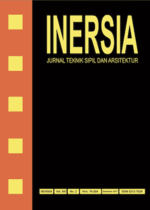The Effectiveness of Stone Column Spacing in Reducing the Potential of Liquefaction
DOI:
https://doi.org/10.21831/inersia.v17i2.44413Keywords:
Likuefaksi, Stone Column, Quake/WAbstract
ABSTRACT
Liquefaction is a liquefied soil phenomenon caused by cyclic load or earthquake. One of the soil liquefaction prevention methods is the installation of stone column. The stone column is a column filled with compacted rock fragments. It has 50 cm in diameter and 5 m deep This method is believed to reduce the excess pore water pressure that occurs during an earthquake. The stone column has been applied in many construction projects which located in high potential of liquefaction area. This research aims to know the effectiveness of stone column in reducing the liquefaction potential. This research conducted by using borelog data and soil laboratory test. This research also runs the numerical simulation of soil liquefaction with stone column stabilization. The variations in column spacing (2 m; 1.5 m; and 1 m) and subsurface review point (1 m; 1.5 m; 2 m; and 2.5 m) will be applied by using Quake/W from Geostudio 2012 software. The results show that the liquefaction potential can be reduced with the closer stone column spacing up to 1.5 m. Reduction of pore water pressure and liquefaction potential only occurs in the initial period of the earthquake before reaching the peak of earthquake acceleration.
ABSTRAK
Likuefaksi merupakan fenomena pencairan tanah akibat adanya beban siklik atau gempa. Salah satu metode penanganan likuefaksi yaitu dengan melakukan instalasi stone column. Stone column merupakan suatu kolom yang diisi oleh fragmen batuan yang dipadatkan. Umumya kolom berukuran diameter 50 cm dan kedalaman hingga 5 m. Metode ini dipercaya dapat mengurangi tekanan air pori yang terjadi pada tanah saat gempa. Penelitian ini bertujuan untuk mengetahui efektifitas stone collumn dalam mengurangi potensi likuefaksi. Penelitian ini dilakukan dengan menggunakan data bor dan uji laboratorium. Simulasi numeris juga dilakukan berupa permodelan tanah dengan stabilisasi stone column. Variasi pada jarak stone solumn (2m; 1,5m; dan 1m) dan titik tinjau (1m; 1,5m; 2m; dan 2,5m) dilakukan dengan menggunakan perangkat lunak Quake/w dari Geostudio 2012. Hasil menunjukkan bahwa potensi likuefaksi dapat berkurang dengan jarak stone column yang semakin dekat hingga 1,5 m. Pengurangan tekanan air pori dan potensi likuefaksi hanya terjadi pada periode awal gempa sebelum mencapai puncak percepatan gempa.
References
B. M. Das and G. V. Ramana, Principles of Soil Dynamics second edition. Stamford: Cengage Learning, 2011.
T. W. Buana et al., "Atlas Zona Kerentanan Likuefaksi Indonesia," Bandung, 2019.
Committee on Earthquake Engineering, Liquefaction of Soil During Earthquakes. Washington D.C: National Academy Press, 1985.
T. Shenthan, R. Nashed, S. Thevanayagam, and G. R. Martin, "Liquefaction mitigation in silty soils using composite stone columns and dynamic compaction," Earthquake Engineering and Engineering Vibration, vol. 3, no. 1, pp. 39–50, 2004, doi: 10.1007/BF02668849.
Z. Ben Salem, W. Frikha, and M. Bouassida, "Effects of granular-column installation on excess pore pressure variation during soil liquefaction," International Journal of Geomechanics, vol. 16, no. 2, p. 04015046, Jun. 2015, doi: 10.1061/(ASCE)GM.1943-5622.0000516.
J. Castro, Modelling Stone Columns. MDPI, 2017.
M. Arif, A. Rifa'i, and F. Fikri, "Liquefaction potential analysis on runway construction based on soil engineering properties," 2020.
A. Hara, T. Ohta, M. Niwa, S. Tanaka, and T. Banno, "Shear modulus and shear strenght of cohesive soil.," J-Stage, vol. 14, no. 3, pp. 1–12, Sep. 1974, doi: 10.3208/SANDF1972.14.3_1.
R. Kumar, "¢ Kapilesh Bhargava, and D. Choudhury, "Estimation of Engineering Properties of Soils from Field SPT Using Random Number Generation," INAE Letters 2016 1:3, vol. 1, no. 3, pp. 77–84, Oct. 2016, doi: 10.1007/S41403-016-0012-6.
Badan Standardisasi Nasional, SNI 8460:2017 Tata Cara Perencanaan Ketahanan Gempa untuk Struktur Bangunan Gedung dan Non Gedung. Jakarta: Badan Standardisasi Nasional, 2017.
J. Castro, M. Karstunen, and N. Sivasithamparam, "Influence of stone column installation on settlement reduction," Computers and Geotechnics, vol. 59, pp. 87–97, Jun. 2014, doi: 10.1016/J.COMPGEO.2014.03.003.
Downloads
Published
How to Cite
Issue
Section
License
Authors who publish with INERSIA journal agree to the following terms:
- Authors retain copyright and grant the INERSIA journal right of first publication with the work simultaneously licensed under Creative Commons Attribution License (CC BY 4.0) that allows others to share the work with an acknowledgment of the work's authorship and initial publication in this journal.
- Authors can enter into separate, additional contractual arrangements for the non-exclusive distribution of the published version of the work (e.g., post it to an institutional repository or edit it in a book), with an acknowledgment of its initial publication in this journal.
- Authors are permitted and encouraged to post their work online (e.g., in institutional repositories or on their website) before and during the submission process, as it can lead to productive exchanges, as well as earlier and greater citation of published work.

INERSIA by https://journal.uny.ac.id/index.php/inersia was distributed under a Creative Commons Attribution 4.0 International License







